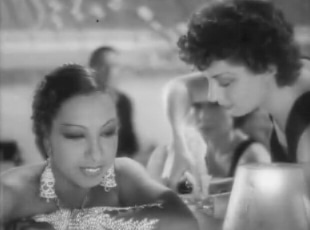Princess Tam Tam is partly set in Tunisia, where Baker plays a humble, carefree, penniless, and childlike shepherdess. 1 She steals an orange in a market. Max de Mirecourt buys the whole basket and hands it to her. She runs away with a flock of children in her wake. Later, dressed in a Roman toga complete with a brooch, she dances at the summit of a Roman amphitheater. It must be noted that the film was shot on location courtesy of the Services de propagande de la Résidence Générale, the Tunisian colonial authorities. As such, it participates in the French colonial venture, offering idyllic visions of Roman ruins (Dougga) with aloe plants in the foreground, aristocrats going on a tour with a local guide and picnicking in the open air, and the local color of the market scenes. The numerous ironies of the film may originate in that first “native” geography: the market scenes belong to the genre of the “documentary,” the Arabic spoken by one of the vendors is “authentic,” the street urchins are not actors, and the colonial imaginary is embedded in the ruins of the Roman Empire. 2 Thus the motion of serial embeddedness, or regress ad infinitum—the profound specularity of the film that goes hand in hand with its “lightness” as entertainment—might find its source in this casting of Tunisia as a province of the Roman Empire. While Alwina/Baker dances steps borrowed from the African-American stage routine at the core of her repertoire as a dancer, her partner-to-be in the conclusion of the film, the “indigenous” Tahar, is a black-faced French actor wearing a tarbush to camp him as the archetypal Muslim man, the Mohammedan. 3

The Parisian scene abounds with characters from the French colonial empire. Max de Mirecourt’s wife flirts with the maharajah of Madane to provoke her husband’s jealousy, thus introducing a playful symmetry: while he fantasizes about the transformation of Alwina into a parisienne and she in turn falls in love with him, the real parisienne has an affair with a man from the Orient. 4 In a scene that features a party given by the maharajah in a luxury nightclub, constituting one of the major narrative sequences of the film, the dancers—and an intoxicated Alwina—break into the conga.[video] The choreographies are a mixture of French music hall, the American tradition of the revue and its innumerable chorus girls, and popular Brazilian music. The bustling hybridity of the product, as well as the assemblage of ready-made objects from the colonial image-repertoire, is suitably dazzling. Tunisia itself metonymically stands in for Africa and the savages. Baker explains:
One of the things that I particularly enjoyed about filming Princess Tam Tam was the chance it gave me to introduce the conga to France. Not that the conga had anything to do with Tunisia; it was a dance enjoyed by the slaves after their work was done. We were all convinced that it would be the rage in Paris that winter. What better way to keep warm? 5
This display of a plurality of colonial locations directly corresponds with the fact that Josephine Baker, a black American of mixed origins—white, Native American, and black, if we are to believe her numerous autobiographies and biographies—could be cast as an array of colonial female subjects: West Indian, Tunisian, Tahitian, African, and Arabic. She could also sing Vincent Scotto’s 1906 number, which was part of Mistinguett’s repertoire, “Ma Tonkinoise,” and thus include Le Tonquin/Indochina within the ever-expanding boundaries of the French territories that she could represent. At the same time, Baker’s “Americanness” and her “blackness” were other facets of her persona of difference that allowed her to supersede the French popular stars of the music hall, Mistinguett included. There were other black female performers at the time, such as Maud de Forest, Florence Mills, Bricktop, and Benga, but Baker outshone them. In other words, her exoticism, based on something perceived as escaping the French empire, was all the more alluring. In addition, her belonging to two countries (“J’ai deux amours“) and her adoption by the French was a comment on American racial politics. In effect, her “identity” became increasingly blurred with each of the disguises she put on—with each of the roles she performed. Her national origins, her date of birth and her lineage—in short her “civilian” identity—was lost, veiled and displaced, yet it remained as a vanishing point. The following lines from her Mémoires are typical of her counter-pointing the way in which art critics viewed her:
In the magazines and newspapers of Berlin, they wrote that I was a figure of contemporary German expressionismus, of German primitivismus, etc….
They are funny.
And what does it mean? I was born in 1906, twentieth century.
Alles für Josephine.
Funnier and funnier. And why not? (M, 121)
- Biographies also mention Tangiers as another possible location.[↑]
- Baker mentions that she was often taken for an Arab in Tunisia: “Between takes, people hail me in Arabic, and naturally, I understand nothing. They became quite aggressive at times. I questioned our interpreter who informed me that the Arabs, convinced that I am one of them, wondered with certain vehemence why I didn’t answer them. This proves how well cast I have been.” Joséphine Baker and Jo Bouillon, Joséphine (Paris: Robert Laffont, 1976), p. 143, translation mine. English translation by Mariana Fitzpatrick, (New York: Marlowe and Company, 1988), p. 100.[↑]
- Tahar is named Dar (house in Arabic) in the subtitles of the Kino version.[↑]
- The French established numerous counters in India in the 16th century (Pondichery, Zanzibar, Chandernagor), and their influence prevailed over a large part of India’s territory in the 18th century.[↑]
- Joséphine Baker and Jo Bouillon, Joséphine (Paris: Robert Laffont, 1976), pp. 100-101.[↑]



